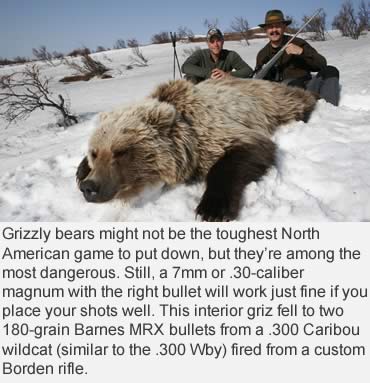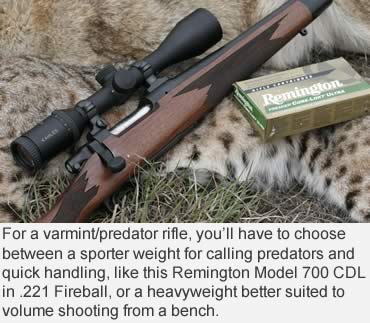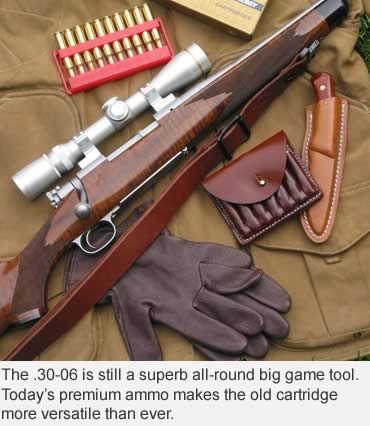Choose carefully, and you’ll be equipped to hunt any game anywhere in the world with just a few rifles.
So you are a rifle hunter. Welcome to the club. And you’d like to hunt everything all the time? Lucky you. In North America, you could spend a lifetime pursuing a wonderful mixed bag from small rodents through the biggest deer in the world. You’ll hunt in a stunning reach of country with varied habitats. You could be shooting from 10 feet to 1,000 yards at animals weighing a half-pound to 2,000 pounds. Journey to other continents and you’ll find even more strange and wonderful beasts.
And you can take them all with just four rifles.
Four rifles hardly seem like a good start to a real gun nut, but not all of us have the time, money nor patience to acquire dozens of specialty firearms. A careful hunter could tackle all North American game and most African ungulates with just one rifle, but shooting ground squirrels with a .375 magnum isn’t much fun, no matter how much you download. Four rifles is a reasonable program, and here’s how to pull it off.
Small But Deadly
Everyone’s first rifle should be a .22 Long Rifle. Small, versatile, inexpensive, quiet and surprisingly deadly. It’s the perfect tool for learning to shoot, honing accuracy and hunting small game like cottontails, squirrels, marauding crows, skunks, foxes, and jackrabbits. The cheapest ammo is .22 LR. It’s quiet, too, so you can shoot it in settled areas without disturbing the peace.
The lowest-power ammo can be shot indoors with the proper backstops. Subsonic rounds really keep the noise down. Hyper-velocity fodder provides dramatic upset on small game within 50 yards or so. If push came to shove and I had to choose just one rifle to survive, it would be a .22 LR.
To really bring out its best, top it with a variable scope in the 2x to 16x range that has an adjustable focus for removing parallax. This’ll make it possible to clearly see (at 10x and higher) a tiny squirrel head peaking over a limb at close range.
 Varmint/Predator Poison
Varmint/Predator Poison
If you plan any long-range varminting or predator hunting, you’ll want a small-caliber, flat screamer that’ll shoot accurately and far. Most reasonable are .224 and .243 calibers. The .223 Rem is economical, but a bit weak beyond 300 yards. The .22-250 Rem, .220 Swift and .223 WSSM are effective to 350 to 400 yards with the right bullets. For optimum resistance to wind drift, fire 60- to 80-grain bullets with high Ballistic Coefficient numbers. You’ll need a 1-8-inch twist barrel to stabilize such long projectiles. If you handload, consider a faster Ackley Improved chamber or some .224 wildcat.
The alternative is the slightly larger .243 caliber in the .243 Win, 6mm Rem, .240 Wby, and .243 WSSM. The last three are poorly represented in factory ammunition, and the WSSM’s future is uncertain, so the .243 Win is your best option if you don’t handload. This little number will do anything the hot .224s will do, plus handle deer and pronghorns a little better with 80- to 100-grain bullets at 3,000 to 3,100 fps. A good bullet in a .224 kills deer just fine, but isn’t legal for this use in many states. Light, 55- to 70-grain pills in .243 Win make this a 4,000- to 3,600-fps screamer for varmints. So consider the .243 Win as a great, versatile varmint/predator/small deer rifle.
On the fringe of this category are the .25 calibers, specifically the .257 Roberts, .257 Roberts/Ackley, .25-06 Rem, .25 WSSM and .257 Wby. While excessively powerful for high-volume, extended varmint shooting with 80- to 100-grain bullets, they excel at shooting long in the wind with super-efficient, high BC 120- to 140-grain pills that penetrate deeply. This makes them ideal for coyotes, but they’re quite powerful enough for deer, sheep, goats, black bears and even elk in the right hands. The faster .25s are rather a borderline case that could squeak into the next category.
 The big question with the varmint/predator rifle is the platform. A heavy barrel and stock are best for extended-range volume shooting off bench or bipod. A sporter-weight barrel/stock is best for hiking the plains and swinging on running predators. Which will you do most? You may need one of each, which would put you in the five-rifle club unless you can live without the dangerous-game category. A third option is a modular switchbarrel rifle like the Blaser R-93 or T/C Encore.
The big question with the varmint/predator rifle is the platform. A heavy barrel and stock are best for extended-range volume shooting off bench or bipod. A sporter-weight barrel/stock is best for hiking the plains and swinging on running predators. Which will you do most? You may need one of each, which would put you in the five-rifle club unless you can live without the dangerous-game category. A third option is a modular switchbarrel rifle like the Blaser R-93 or T/C Encore.
My solution would be the latter or a traditional sporter-weight rifle in .243 Win because I love calling coyotes and bobcats, but would be happy firing just a few boxes at chucks and prairie dogs each spring.
No varmint/coyote rifle is complete without a versatile variable scope. You don’t need a huge objective for diurnal squirrel shooting, but the big front element could add precious light for dawn and dusk predators.
Since this rifle won’t likely be carried miles a day over mountains, the additional bulk/weight of a 50mm objective won’t kill you, so get one if your scope’s power goes above 10x. I’ve handled prairie dogs to 400 yards at 10x, but more magnification is useful for prolonged, serious long-range rodent shooting.
Some of today’s wide-zoom-range scopes like the Bushnell 6500 series and Swarovski Z6 let you zoom 6.5 or 6 times, respectively. This means you can have a low-end power of 3x for close-cover predators nearly 20x for extreme range.
 Deer & Elk
Deer & Elk
Here’s your workhorse for big game hunting. Think 6.5mm through .308. That would be .260 Remington through the .300 magnums. Shoot 100- to 130-grain bullets for coyotes and even a few varmints now and then. Pick your shots with the right heavy premium bullet and even the “puny” .260 Rem will handle elk and moose. If you don’t want to take chances, there’s the .30-378 Wby, .300 RUM, 300 WSM and more.
Today’s premium controlled expansion bullets increase efficiency of all calibers. So pick anything including .264 Win Mag, 6.5-284 Norma, .270 Win, 7mm-08 Rem, .280 Rem, .284 Win, 7mm Rem Mag, .30-06 or and any of the short magnums from Remington, Winchester and Ruger.
I consider rifle weight and balance as critical as caliber and horsepower. If the gun is too long, heavy or unwieldy, I won’t hunt as far or as long as I should. Getting deep into the field and staying there is important for consistent success. For me, a 10-pound 7mm Rem Mag with a 24-inch barrel might not be as effective on elk as a 5.4-pound UltraLight Arms .284 Win.
Will this work for you, too? It depends on how much recoil you can handle and what makes you happy. Would you prefer more recoil or lugging a heavy rifle on your hunts?
My ideal rig is a field-ready rifle (sling, scope, full magazine) with a 21- to 23-inch barrel weighing 5.5 to 7.5 pounds.
I prefer to shoot high-BC, premium bullets weighing 130 to 180 grains. For sighting, I like a midrange variable scope with fairly small objective. This keeps weight down and doesn’t unbalance the gun.
Big game from pronghorns to moose are large targets, so you don’t need 10x, let alone 20x. Keep the power below 10x and you won’t need a monster objective to bring in enough light to see the game through legal shooting light. A 2-8x36mm or 3-9x42mm is sufficient for me. If you shoot mostly at twilight in deep woods, consider an illuminated reticle.
 Oversized, Dangerous Game
Oversized, Dangerous Game
This category is out of reach for many of us. If you never intend to hunt brown bears, cape buffalo or elephants, trade the big bore for a specialty varmint or coyote rifle. But just in case you win the lottery, let’s gear up for the big stuff.
While I’ve shot .416s, .458 Lotts and .470 Nitros, they were never aimed at game, so my knowledge of terminal performance comes secondhand. I’ve taken a grizzly, five or six bull moose, the largest African antelope and an Australian water buffalo with .270, .300 and .330 magnums, and ever felt undergunned. But for even bigger stuff, read on.
Since .375 H&H Magnum is minimum legal size in some countries, let’s start there. Otherwise, we could consider the .325 WSM and .338 magnums, which are ideal for elk, moose, eland and bears. But for truly dangerous game, back to that .375 caliber in the H&H, Ruger, RUM and Wby. The .450/400 Nitro and .405 Win are enjoying a small revival, but better are the .416 magnums and .404 Jeffrey, about the maximum power part-time hunters can handle.
When you jump to the .458 Win and Lott, flinching becomes a serious problem. In .460 Wby, .470 NE, .505 Gibbs and up, we’re talking true specialty rifles few sport hunters would ever need. But again, this is your party, and there’s even bigger stuff out there.
In rifles, you have two options: a well-built, controlled-round-feed bolt action or a side-by-side double. Neither comes cheap, but the double is truly expensive.
Scopes are generally not recommended unless they are small, light, extremely rugged and 1.5x to no more than 5x on quick-detach mounts that expose the open sights. Most wannabe big-bore hunters opt for a factory bolt action from the likes of Remington, Ruger, Winchester, etc., chambered in .375 H&H to .416 Rem.
 Most Critical
Most Critical
Regardless which rifles, actions, scopes and calibers you include in your four-rifle battery, don’t forget the most critical ingredient — teaching yourself to shoot them!
Shooting well is a matter of learning good technique, and practicing it until it’s second nature, until muscle memory practically does the work for you. This will be easier if all of your firearms are of the same basic action, style and function. You don’t want to be switching from a lever-action .22 LR to a bolt-action .243 to an autoloader .270 to a double-barrel .470 Nitro. Maintain the same actions, but also keep safeties the same if you can. Jumping from a tang to a side-position switch can mess you up and waste precious seconds.
If you prefer to mix actions and brands, at least practice extensively with the rifle you’re going to use on your hunt.
Finally, select the proper ammunition and bullets for each task. Bullets make the most difference in terminal performance with any hunting rifle or cartridge. That and the ability to put them in the right place. Back to practice. Bingo. You’re set for a lifetime of hunting fun and success.
Read More Articles by Ron Spomer:
• Are Wildcats Worth It?: Your heart palpitates for a custom chambering, but think before you leap.
• 10 Steps to a Tack Driver: Turning a so-so shooter into a MOA rifle might be easier than you think.
This article was published in the November 2009 edition of Buckmasters GunHunter Magazine. Subscribe today to have GunHunter delivered to your home.